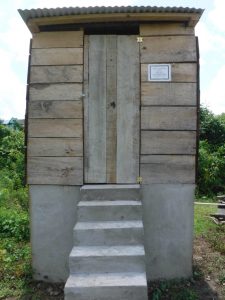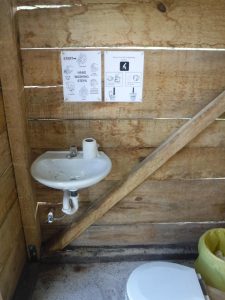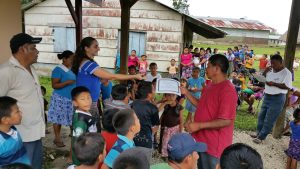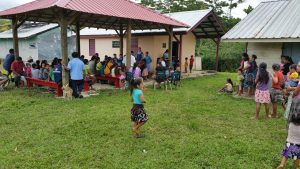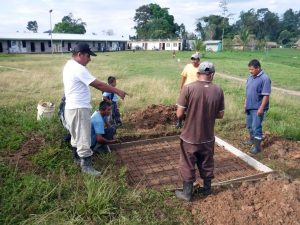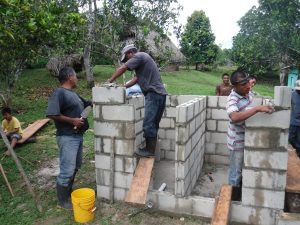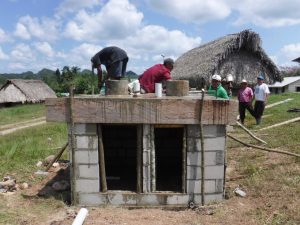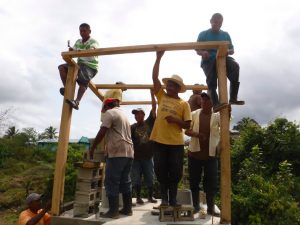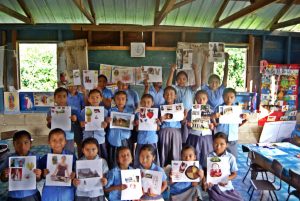 This project has been completed. To read about the conclusion, CLICK HERE.
This project has been completed. To read about the conclusion, CLICK HERE. ![]()
This project is made possible through the partnership of WATER CHARITY and the NATIONAL PEACE CORPS ASSOCIATION.
Location
San Benito Poite, Toledo District, Belize
Community Description
San Benito Poite is a remote village found in the southwestern corner of Belize close to the border of Guatemala. The roughly 515 people who reside in the community are Q’eqchi Maya and speak the Q’eqchi language, with students learning English when they enter school.
The majority of people are sustenance farmers who rely on annual crops, such as corn and beans, and livestock for both food and income. Each morning, the men leave for their farms while the women send their children to school, either to the high school, a two-hour bus ride away or to the primary school located in the village. The women then begin their daily tasks of maintaining the household, including washing clothes and dishes at the river, sweeping the house, and tending to the animals, usually pigs and chickens. They are responsible for preparing lunch for their children who return from school to eat, as well as for their husband when he returns from the farm.
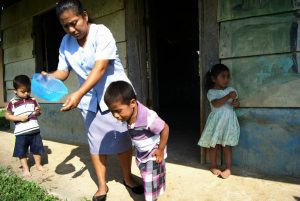 The community has little access to modern amenities due to its distance from town. The village bus runs only four days a week with a travel time of three hours to reach the town. The majority of families rely on a single solar panel to provide light in the house, though for the five to the six-month-long rainy season the panels are unreliable due to the constant rain.
The community has little access to modern amenities due to its distance from town. The village bus runs only four days a week with a travel time of three hours to reach the town. The majority of families rely on a single solar panel to provide light in the house, though for the five to the six-month-long rainy season the panels are unreliable due to the constant rain.
Each household has a pipe that provides potable water that is pumped from a nearby source through the central chlorinated water tank. However, this risks drying up during the hottest months as demand increases. As a result, women will use fire hearths for cooking and the river for washing.
The people of San Benito Poite truly embody the sense of the word community. Celebrations, including weddings and holidays, are celebrated community-wide. When a man plants his crops, he invites on average fifteen to twenty male family members and friends to assist while the women will cook the traditional meal of Caldo soup and tortillas to feed the family and friends in thanks. The majority of community members attend their respective churches multiple days each week, which has fostered the creation of sub-communities that are invited to family functions such as birthdays or baptisms.
Problem Addressed
Many rural villages in southern Belize face high rates of gastrointestinal diseases, with many children visiting clinics with diagnoses of gastroenteritis. These diseases are most commonly caused by the consumption of food and water contaminated through poor hygiene practices, including improper handwashing, defecating in the open, and not covering food.
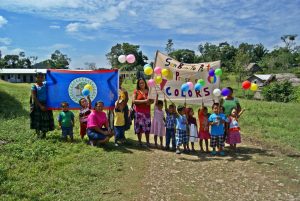 From January 2016 to July 2016, the Belize Ministry of Health, Public Health Department tested the water quality of rudimentary water systems in 37 villages in the district of Toledo. These systems pump water from a well in the village into a holding tank before it is pumped back into the village for drinking, cooking, and washing use. Twenty-one of the 37 systems tested positive for E.coli bacteria. When one consumes contaminated water and is forced to defecate in the open because of a lack of latrines, they expose others to pathogens and begin the fecal-oral cycle of disease.
From January 2016 to July 2016, the Belize Ministry of Health, Public Health Department tested the water quality of rudimentary water systems in 37 villages in the district of Toledo. These systems pump water from a well in the village into a holding tank before it is pumped back into the village for drinking, cooking, and washing use. Twenty-one of the 37 systems tested positive for E.coli bacteria. When one consumes contaminated water and is forced to defecate in the open because of a lack of latrines, they expose others to pathogens and begin the fecal-oral cycle of disease.
In San Benito Poite, the majority of the 102 households are forced to find semi-secluded areas in the bush to defecate. As the village is expanding and new families are building houses, plots of land are becoming smaller and the bush between houses is shrinking. Many people are required to walk a far distance to defecate, and children who are too young to walk far are forced to defecate in the yards just outside of the houses. Animals that roam free in the village, including pigs and chickens that families eat, consume the feces and track them onto the road and throughout the village.
During the rainy season lasting from June to December, feces are washed into the yards in which barefooted children play, and into the surrounding rivers in which community members bathe and wash clothes. The heavy rains and a high water table leads to frequent flooding, many times flooding the few pit latrines that some households have. As a result, waste leaks into the ground and potentially disease-carrying mosquitoes are attracted to the stagnant water.
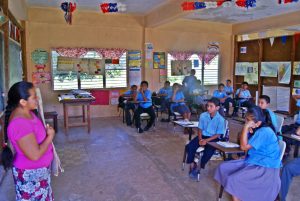 Project Description
Project Description
This project is to build five dual-vaulted raised pit latrines with handwashing stations. They will be located at each of the 5 churches in the village.
A dual-vaulted raised pit latrine is a latrine in which the human waste is collected within a concrete structure built above the ground. The concept is to have a latrine that can be re-used infinitely while creating a safe and useful way of disposing of the waste. Community members will use only one side of the latrine, or one vault until it fills up. Once that is filled, it will be closed off and community members will use the other side of the latrine, the second vault. While using the second vault, the waste in the first vault will go through a degradation process and after a few years, will be converted into compost and used for gardens or farms.
The project will begin with a two-day training of 10 community members hosted by the local non-governmental organization (NGO), Maya Mountain Research Farm. The 4 members of the San Benito Poite Health Committee, village leaders, and church pastors will make up the group of ten members who attend this training. The training will cover the concept of a dual-vaulted raised pit latrine, how to construct one, how to maintain the latrine, and how to properly use the compost.
Once this training is complete, those who attended will host their own educational sessions in their respective churches to explain to the members what they had learned. Along with these sessions, the community health worker and Peace Corps Volunteer will conduct educational sessions on diarrheal disease prevention and management, including water treatment methods. A total of 5 of these training will be conducted, one in each church.
When the training is complete, the materials will be ordered and delivered to the community. Once the materials arrive, two staff members of the NGO Maya Mountain Research Farm (MMRF) will come to the community and do a hands-on practical and assist in building one of the 5 latrines and its handwashing station.
Each church will be responsible for sending its members to the construction to learn the techniques. The latrine will be built over the course of 2 weeks with the project partners from MMRF working 4 days to demonstrate and teach the proper construction techniques. Once this first latrine is built, the 4 other churches will be responsible for building their own latrine.
A manual will be produced describing the project, to be used as a reference throughout the project and during potential expansions in the future. It will begin with a description of the problem, including the consequences of open defecation and the importance of using a latrine. It will provide step-by-step instructions and illustrations of the construction of the latrine. Lastly, it will include explanations of how to maintain the latrine and how to properly remove and use the compost.
Each church will receive a copy of the manual to use as a guide when building their respective latrine. Additional copies will also be used to disseminate to other communities or parties interested in adopting this project.
The construction of the latrine will begin with laying a 4” thick foundation supported with 3/8″ rebar on the ground. These latrines will have a foundation size of 6’8″ by 5’4″. Four-inch cement blocks will then be laid around the edge of the foundation 7 blocks high as well as halfway between the foundation running from the front to back to create the dividing wall for the two vaults. Each vault will then be 3’4″ by 5’4″.
The total height of the concrete structure will be 4’8”. The back of the latrine will have two 2’ by 3’ spaces left open in the blocks, one for each vault, where the doors for retrieving the compost will be placed. The doors will be made of metal sheeting and attached with steel hinges and cement nails.
At the back of the latrine, one 3” PVC pipe elbow will be placed in the wall of each vault and then connected to a 10’ PVC pipe running vertically and extending above the latrine for ventilation out of the vaults. Additionally, a piece of 1½” PVC piping will be placed on the bottom of each vault with the end extending out to provide for drainage of excess liquid in the vault.
A 4”-the thick concrete floor will be laid with two circular holes left for where the concrete toilet seats will be placed. The stairs will be built using concrete and rebar at a 45-degree angle with rebar placed every 2 feet.
Once the bottom structure is complete, the superstructure can be constructed. This will be made of wooden posts and boards attached to the bottom structure with steel L brackets, threaded rods, nuts, and washers. The roof will be three sheets of 8′ by 33″ corrugated zinc and attached to the superstructure with roofing nails.
The handwashing stations will consist of a sink basin and faucet that is connected to each church’s water pipe. Water in the village is distributed through underground PVC pipes from the water tank. This water is pumped from a nearby source and treated with chlorine to make it potable.
Each church will receive PVC piping and connections to connect their handwashing station to the water system. PVC piping will also be used to direct the wastewater from the handwashing station to a lower-lying area filled with banana leaves, twigs, and charcoal to collect and filter the water. Banana trees will be planted surrounding the pit to use the water and produce a sustainable crop for the village.
Water Charity funds will be used to purchase the construction materials, including the cement, sand, blocks, the various PVC pipes, the roofing material for the roof and doors on the vaults, the sinks and components, nails, rebar, and the tying wire.
The community of San Benito Poite has been instrumental in the design and planning of the project. A 4-member health committee has led the charge in gauging community interest and support for community latrines. The San Benito Poite Health Committee initiated the project with a community meeting to share their project concept. The meeting produced positive responses and thus was followed-up by individual household surveys. Over the course of a few months, the health committee visited all 102 families and five churches in the village.
Each church has committed to providing all of the lumber to construct the superstructure above the vaults, the labor for building, as well as the land where the latrine will be built.
Project Impact
515 people will benefit from the project.
Peace Corps Volunteer Directing Project
Amanda Masse
Monitoring and Maintenance
The health committee is responsible for conducting monitoring and evaluation sessions with project participants to ensure proper latrine construction and use. They will evaluate best practices and lessons learned throughout the project implementation to encourage knowledge exchange and project modifications when necessary. This will provide for future expansion of the project to individual household latrines in order to continually improve the health of the community.
To ensure proper maintenance of the latrine, each church will be required to clean the inside of the latrine once a month. Each church has a collection fund and a small portion of that will be used to purchase cleaning supplies. The cleaning of the latrine will include sweeping and wiping down the toilet seat, sink, and other inside surfaces. The pipe water for each church will be used for the cleaning.
Members of each church will attend a training on latrine maintenance, including adding carbon-loaded materials like rice hulls and sawdust to decrease smell and mixing the waste to encourage pathogen degradation. Lastly, before the latrine is first used, rice hulls will be added to the bottom of the constructed latrine to assist in reducing the smell for future use.
Since community members will actively learn how to construct the latrines, they will learn how to repair it if it were to break. Additionally, each church has agreed to maintain ownership of the latrine and therefore ownership of paying for and repairing it should it break.
To mitigate the potential for antibiotic-resistant bacteria entering the environment, community members will receive thorough training on the management and handling of compost to ensure proper degradation.
To ensure that the latrines are built and maintained properly, the local Public Health Inspector will inspect the five latrines to deem them fit for use. He will view them initially before the community first uses them, and when conducting water quality tests, they will conduct follow-ups.
Fundraising Target
$5,600
Funds raised in excess of the project amount will be allocated to other projects in the country.
Donations Collected to Date
$5,600
Dollar Amount Needed
$0 – This project has been funded through the generosity of the Paul Bechtner Foundation.
Additional donations will go toward funding other projects in Mexico.
Conclusion of San Benito Poite Public Latrine Project – Belize
This project has been completed under the direction of Peace Corps Volunteer Amanda Masse. To read about the start of the project, CLICK HERE.
Amanda reports:
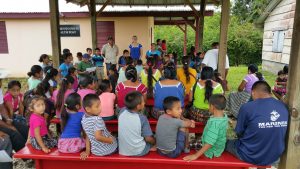
Scope of Work:
The San Benito Poite Latrine Project had two goals in its scope of work. The first goal was to increase the number of functioning latrines in the community to help promote the adoption of healthy behaviors among community members. This was to be achieved through the construction of five latrines with handwashing stations, one for each church in the community. As a result, community members would have the supporting infrastructure to adopt the healthy behaviors of defecating in a clean and appropriate space and being able to wash their hands after.
The second goal of the project was to decrease the incidence of diarrheal diseases in the community through the use of new and clean composting latrines. To achieve this goal, latrines were constructed to remove feces from the environment and reduce contact of community members to potentially disease-carrying feces. Additionally, the latrines had sunk to encourage proper hygiene practices of handwashing. Lastly, community members were trained in proper hygiene practices like handwashing as well as water treatment methods. Specific Work Done:
Community members of San Benito Poite completed a variety of tasks to ensure the successful completion of this project. The project began with the house to house surveys of all families in the community. Once the need for latrines was identified, the health committee and village leaders designed a project and submitted a grant proposal. Once the proposal was approved, the health committee expanded into the nine-person latrine committee. This committee then was responsible for attending the two-day training with the third-party work partner. After returning to the community, they each gave training on what they had learned to members of their respective churches.
Once the training was completed, material deliveries had to be coordinated. Committee members were responsible for receiving deliveries and unloading materials to each church. The next step was to build construction which required committee members, village leaders, and community members to level the spot for each land, build the complete latrine, and connect the sinks to the community water system. The last step to make the latrines functioning was to coordinate a pickup of rice hulls for the churches. A few committee members traveled out to collect 20 bags of rice hulls and bring them back to the community to lay the base layer of carbon. Each latrine now has their own bags of rice hulls for people to use when using the latrine.
Committee members also are helping to write and translate the manual that will be published as the last step of the project.
How work progressed through each stage:
The first phase of the project focused on training community members on the construction and maintenance of the latrines. Nine community members who made up the Latrine Committee attended a two-day workshop at the Maya Mountain Research Farm (MMRF), the project’s third-party work partner. All members of the committee attended the workshop and greatly valued the information they learned. While at the training, the committee members were able to ask questions specific to how fecal degradation works and how to use the resulting compost. The concept of adding carbon materials, such as rice hulls or sawdust, was new and something they were thankful to learn about.
After attending the training, the committee members then facilitated their own training/information sessions in their respective churches. The key concepts that they discussed with other community members were the importance of the latrine, how to use the latrine, what items could and couldn’t be placed in the latrines, and methods of prevention of diarrheal diseases including proper handwashing.
The second phase of the project was the construction of the actual latrines. In the proposed project, the third party-work partner was supposed to visit the community to complete one of the latrines in hands-on training with community members. Due to scheduling and weather conflicts, they were not able to do this. In turn, the committee members approached other community members who have experience in pouring foundations, laying blocks, and creating wooden structures. They were asked to help assist in leading the construction to ensure that it was done properly.
The construction started in the second week of March by pouring all of the foundations in two days. Over the course of two weeks, a total of 59 men from the community rotated their days of work between the different churches to complete the five latrines. The latrines were built in five stages. The first step was to pour the foundation and place the first layer of blocks. The second step was to lay all of the blocks and prepare and pour the concrete toilet chutes. The third step included pouring the floor and stairs for the latrine. This entailed placing the dried cement toilet chutes on the floor as well as the ventilation pipes. The fourth step was to complete the wooden superstructures. The final and fifth step was to create the metal doors to close the vaults for the latrine and install the sinks.
Each step required roughly a half-day worth of work. While the men were working in the morning, the women from that respective church were preparing lunch for the workers that were helping. Once they finished working and ate lunch, the men would then go to a different church and proceed with construction for that latrine. Again, the women were preparing food for dinner for when construction was done for the day. By the end of two weeks, all five latrines were constructed and the sinks were hooked up to the water system in the village.
The third phase of the project is the publication of a manual that will discuss the importance of waste management and latrines and will provide instructions on how to build the latrines. The purpose of this manual is to have it available to individuals as the second phase of the San Benito Poite Latrine Project begins providing latrines for households. The manual is in a draft phase currently, but hopefully should be completed and printed shortly.
End result
The end result of the San Benito Poite Latrine Project is the construction of a total of five dual-vaulted composting latrines with handwashing stations, one for each of the five churches. Additionally, community members experienced knowledge increase in latrine maintenance, usage of compost, and diarrheal disease prevention. They also gained capacity in construction skills, including cement mixing and pouring, block laying, plumbing, and wooden structure completion. Now when community members attend church services, they have a safe and clean latrine to use and no longer have to seek out a private space in the bush to defecate.
Quotes from community members:
“I am very thankful for having the latrine. Our church has many visitors from other villages or from different countries and now they have a place to use the bathroom.”
“Latrines are very important for the community and I’m looking forward to the next project where we can get them for the houses.”
We extend our thanks to Amanda for completing this important project.
